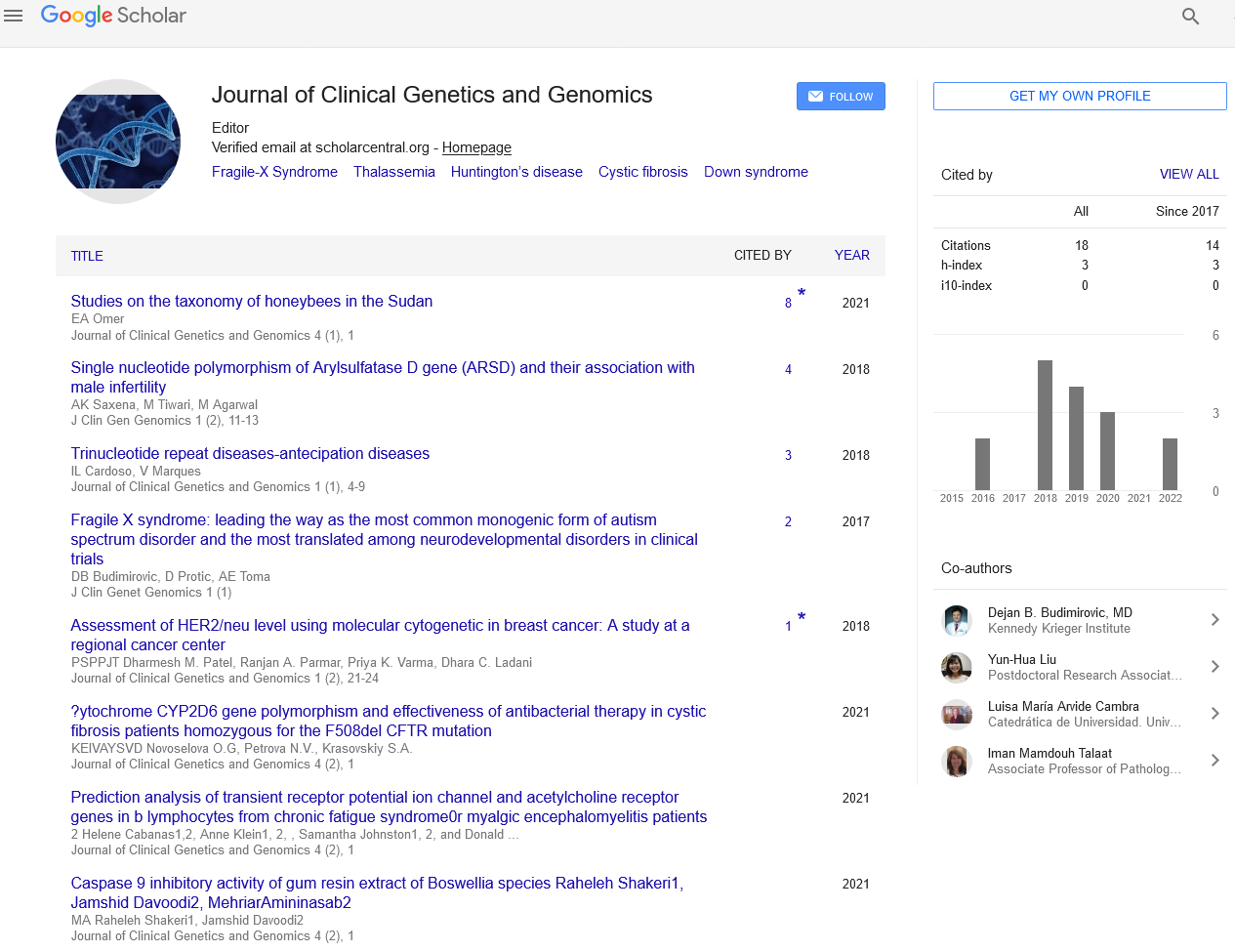The X-Factor: Adrenoleukodys trophy Newborn Screening in the Netherlands
Received: 06-Jun-2022, Manuscript No. PULJCGG-22-5964; Editor assigned: 08-Jun-2022, Pre QC No. PULJCGG-22-5964 (PQ); Accepted Date: Jun 17, 2022; Reviewed: 12-Jun-2022 QC No. PULJCGG-22-5964 (Q); Revised: 15-Jun-2022, Manuscript No. PULJCGG-22-5964 (R); Published: 20-Jun-2022, DOI: 10.37532/puljcgg.22.5(3) 1-2
Citation: Potter B . The X-Factor: Adrenoleukodys trophy newborn screening in the Netherlands. J. Clin. Genet. Genom. 2022;5(3):1-2.
This open-access article is distributed under the terms of the Creative Commons Attribution Non-Commercial License (CC BY-NC) (http://creativecommons.org/licenses/by-nc/4.0/), which permits reuse, distribution and reproduction of the article, provided that the original work is properly cited and the reuse is restricted to noncommercial purposes. For commercial reuse, contact reprints@pulsus.com
Abstract
A terrible metabolic illness that affects the brain, spinal cord, and adrenal glands is called X-linked Adrenoleukodystrophy (ALD). The likelihood of acquiring adrenal insufficiency or progressive cerebral white matter lesions (cerebral ALD) in males with ALD is significant. ALD of the brain can be deadly if left untreated. Adrenal insufficiency and cerebral ALD are not risk factors for ALD in women. Male newborn screening for ALD offers immediate therapeutic intervention and prospective monitoring, preventing irreparable harm and saving lives. The recommendation of the Dutch Health Council to include a newborn screening panel for ALD that is only for males was implemented by the Dutch Ministry of Health. The Dutch Health Council's advice to just test boys without collecting any uninvited information presented a problem. We received an invitation to establish the SCAN trial, a prospective pilot study (SCreening for ALD in the Netherlands). The SCAN study's goals include developing a boys-only screening algorithm that identifies males with ALD and without unexpected findings, incorporating it into the framework of the Dutch newborn screening programme without impairing the current newborn screening, analysing the practical and moral ramifications of screening only boys for ALD, and establishing a thorough follow-up that is accommodating to both patients and parents. A screening algorithm that may be incorporated into the Dutch newborn screening programme was successfully created and validated by our team. The "X-counter" is the "heart" of this algorithm. Without considering the presence of a Y chromosome, the X-counter counts the number of X chromosomes. In our 4-tier screening algorithm, the X-counter is integrated as the second stage. In addition, we made sure that our screening system didn't provide any unexpected findings. Finally, we created a multidisciplinary, centralised follow-up protocol that is accommodating to patients and parents. For nations that face comparable moral dilemmas regarding ALD and other Xlinked disorders, our boys-only ALD screening algorithm provides an answer. This alternate approach for screening boys-only could hasten the inclusion of ALD in newborn screening programmes across the globe.
Key Words
Adrenoleukodystrophy; Spinal cord; Multidisciplinary; Newborn screening; X-linked disorders
Introduction
A mutation in the ABCD1 gene, which is found on the X chromosome, results in X-linked Adrenoleukodystrophy (ALD), a severe inborn metabolic defect. The peroxisomal transmembrane protein that carries extremely long-chain fatty acids into the peroxisome is encoded by the ABCD1 gene. When ABCD1 is defective, VLCFA beta-oxidation is hindered, which leads to a buildup of VLCFA in tissues and plasma. The brain, adrenal glands, and spinal cord are all susceptible to ALD. Between the third and tenth year of life, 35% of boys with ALD experience progressive cerebral white matter lesions, and it is well known that this form of brain pathology frequently affects adults as well. Untreated cerebral ALD frequently results in death.
If done at an early stage of the disease, hematopoietic stem cell transplantation can arrest the course of cerebral ALD. Unfortunately, because of the small treatment window and frequent missed diagnoses 80%–90% of male ALD patients will experience adrenal insufficiency throughout their lifespan, with 50% developing between the ages of 5 months and 10 years. Severe clinical symptoms may develop if adrenal insufficiency is not diagnosed at an early stage. Oral hormone replacement therapy is a reasonably simple way to treat adrenal insufficiency. Women with ALD are much less likely than men to develop adrenal insufficiency or cerebral ALD. Early therapeutic intervention and prospective surveillance are made possible by newborn screening for ALD, averting permanent damage and saving lives.
The first American state to include ALD in its newborn screening panel was New York, following the passing of Aidan's Law. In New York State, ALD NBS is carried out using a three-tier methodology. High-throughput flow injection analysis tandem mass spectrometry (FIA-MS/MS) is used in Tier 1 to analyse C26:0 lysophosphatidylcholine. Tier 2 analysis, which uses a more specialised high-performance liquid chromatography-tandem mass spectrometry, is subsequently performed on samples that passed the screening process. Samples move on to tier 3 and the ABCD1 gene sequencing if C26:0-LPC is also found to be increased in the second tier. The United States Recommended Uniform Screening Panel now includes ALD as of 2016. newborns are now being screened for ALD. The screening for Phenylketonuria (PKU) was the initial step in the Netherlands' NBS programme, which now screens for 22 diseases. The Center for Population Screening is in charge of coordinating the Dutch NBS programme (RIVM-CvB). The Netherlands has a voluntary newborn screening programme that is based on the parents' free and informed agreement. The newborn screening programme has strong participation; 99.1% of all infants were checked. With numerous parties engaged and related steps, the Dutch newborn screening system is a complicated business. Both patients and parents in the Netherlands are not charged for newborn screening or paediatric healthcare.





